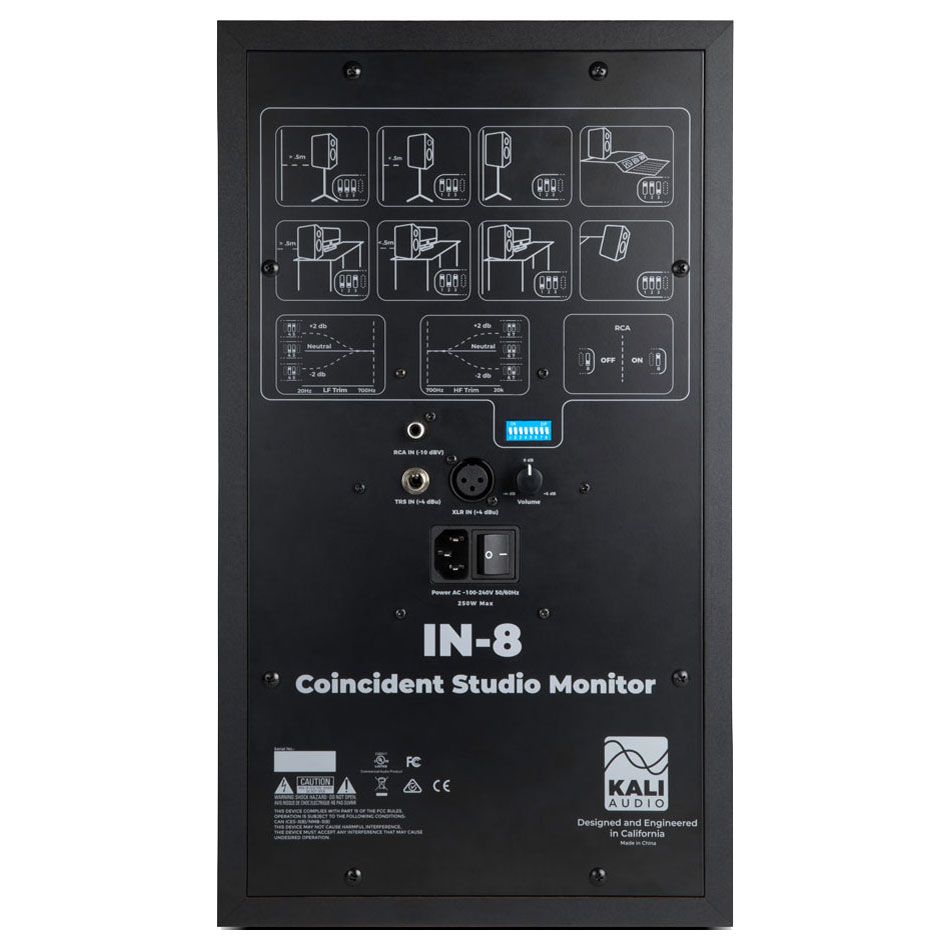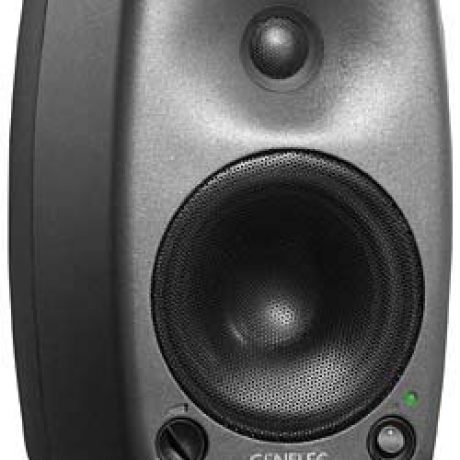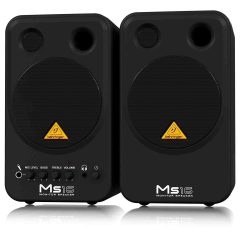| Content |
Project Independence
Kali’s IN-8 is one of the most innovative studio monitors ever made. Combining the natural advantages of a 3-way design with hyper-realistic imaging of a co-axial mid-range and tweeter, it offers more transparency, lower distortion, and a soundstage that must be heard to be believed.
Performance
Power. Detail. Soundstage.
The IN-8 Studio Monitor is a speaker like no other. Using the same woofer and tweeter from Kali’s celebrated LP-8, the IN-8 adds a midrange driver that surrounds the tweeter, and acts as its waveguide.
In doing so, both the tweeter and the woofer are unburdened; with a smaller workload, they are able to play more clearly and with less distortion.
The coaxial nature of the midrange and tweeter make the IN-8 an acoustic point source. Off-axis lobing is thereby eliminated, resulting in a stereo soundstage that presents the listener with a hyper-realistic level of detail.
All of this means that the IN-8 is extremely accurate and easy to mix on, and that mixes made on the IN-8 will transfer wonderfully to other systems.
140W Class D Power
37 Hz Lower Frequency Response
< 1.4% System THD 94 dB @ 1M
114 dB Max SPL
Co-Axial Midrange and Tweeter
A three-way with impeccable imaging.
8-Inch Woofer
Powerful, clean bass. Crossed over at 330 Hz to make the IN-8 an acoustic point source.
Low Noise Port Tube
Precisely engineered using airflow simulations for powerful bass without port noise.
We know. We keep harping on about the "hyper-realistic” imaging of the IN-8. What does that mean?
When you listen to a stereo set of speakers, you’re hearing information about where instruments and players were placed when the material was recorded. Even with purely digital material, producers can manipulate physical locations of elements in the mix, and you will hear these on a stereo recording.
Not only does this allow producers to create interesting spatial effects, but it means that you can work faster and with more confidence. An accurate soundstage lets you "see” each element of the mix in front of you, so you can hear exactly what happens when you make changes.
2-way systems with good waveguides, like Kali’s LP-6 and LP-8, do a good job at conveying this spatial information. However, because the tweeter and woofer on those speakers (and most studio monitors!) are separate, this information gets lost in the space immediately above and below the speaker. This means that at the listening position, you’re not hearing the full stereo picture.
The IN-8 solves this problem. The tweeter and midrange share an acoustic center, and the woofer is crossed over at 330 Hz, so the distance between the woofer and midrange is well under a quarter wavelength at the crossover point. This means that the IN-8 is acoustically a point source. As such, it has the same excellent directivity that the LP-6 and LP-8 have at their sides in a full 360 degrees around the speaker. You’re hearing all of the spatial information at the listening position, so the soundstage that you hear will have every detail that’s present in the mix.
The IN-8’s total harmonic distortion is less than 1.4%, which is exceptional. This is the result of unburdening both the woofer and the tweeter, so that both are doing less work. The woofer is crossed over at 330 Hz, a full 2.5 octaves lower than on the LP-8.
The tweeter is crossed over at 3000 Hz, nearly an octave higher than on the LP-8. Taking up the space in between in the hero of the IN-8 system: the 4-Inch, profile-optimized midrange driver. This driver has a lot of work to do. In addition to reproducing midrange frequencies, it also acts as the waveguide for the tweeter. This means that the shape needed to be precisely engineered to provide an ideal dispersion characteristic for the tweeter.
It also means that the midrange needs to stay still. In many other co-axial or concentric systems, high excursion from the larger driver causes intermodulation distortion, and degrades the accuracy of the system. The midrange on the IN-8 is limited to less than 1 millimeter peak excursion, making it acoustically stationary while still providing midrange to keep up with the powerful woofer and tweeter.
Boundary EQ Control
A speaker’s given position in a space can drastically change it’s frequency response. A speaker placed against a wall or on a desk will sound very different than a speaker placed on a stand, even in a well-treated space. Hard surfaces like walls, desk tops, and recording consoles can change the low end frequency response of the monitor, and degrade the overall clarity of the sound.
Happily, most of the common positions are fairly predictable and easily corrected.
Kali’s team did our Boundary EQ tuning at The Village Studios in Los Angeles, and came up with boundary compensation EQ settings to help you get the optimum sound for where you need to put your speakers.
Combined with the LF and HF trims, this will ensure that the speakers sound their best no matter what room you’re mixing in, or where the speakers are placed.
Easy Connections
The LP-6 and LP-8 both feature balanced XLR and TRS inputs, and an unbalanced RCA input.
The RCA input can be set to -10 dBu sensitivity when you’re using consumer devices like a laptop or smartphone’s headphone jack.
Specifications
| |
|---|
| Powered: |
Yes |
| Amp Class: |
D |
| Power Config: |
Tri-Amped |
| LF Power: |
60 W |
| Mid-Range Power: |
40 W |
| HF Power: |
40 W |
| Total Power: |
140 W |
| LF Driver: |
8\" Poly-Coated Paper |
| Mid-Range Driver: |
4\" Optimized Profile Poly-Coated Paper |
| HF Driver: |
1-Inch Textile Dome |
| Freq. Response (-10 dB): |
37 Hz - 25 kHz |
| Freq. Range (±3 dB): |
45 Hz - 21 kHz |
| LF to Mid-Range Crossover: |
330 Hz |
| Mid-Range to HF Crossover: |
3000 Hz |
| Listening Distance: |
2.8 Meters |
| Max SPL: |
114 dB |
|
PRICE PER UNIT
ADAMs A7 & A7X: the evolution of a legend The predecessor to the A7X, the A7, became the most famous of all ADAM monitors in a very short time. Not only has it been reviewed over three dozen times with outstanding results, it has also received numerous awards. The A7 quickly gained mass appeal, praised in many of the worldʼs largest internet forums. Still today, the A7 are the reference monitors in many smaller studios. With the A7X, ADAM Audio proudly presents the evolution of a legend. It takes everything that made the A7 such an outstanding speaker to a new level. Driver technology The first aspect that distinguishes the old from the new model is the X-ART tweeter. The ʽXʼ stands for ʽeXtended frequency responseʼ and thus for one of the features of the Accelerating Ribbon Technology that has been drastically improved: the frequency response. It now extends all the way up to 50kHz. In addition, the X-ART tweeter has a higher efficiency and higher maximum sound pressure levels. The perfect integration with the lower frequencies has been achieved with a newly designed 7” midwoofer. It has been redesigned with a much bigger voice coil (1.5”) and is driven by an amplifier with twice the power compared to its predecessor. This combination produces an amazing sound and pressure levels with an almost distortion-free musical reproduction. Amplifiers / controls Each driver has its own dedicated amplifier. A 50W A/B amp is responsible for the X-ART tweeter, while the midwoofer is being driven by a 100W PWM amp. The front panel includes a power switch and a control for the volume that retains the volume setting independently from the on/off switch. On the rear panel are several additional controls: a gain for the high frequencies (± 4dB) and two shelf filters for high and low frequencies.
To ensure greater compatibility, there are both XLR (balanced) and RCA (unbalanced) connectors. | Mid-Woofer |
| | Number | 1 | | Basket Ø | 7" (175 mm) | | Voice coil Ø | 1.5" (38 mm) | | Cone material | Carbon/Rohacell/Glass Fiber | | Tweeter |
| | Number | 1 | | Type | X-ART | | Diaphragm area | 4 inch² (2420 mm²) | | Equiv. Diaphragm Ø | 2" (56 mm) | | Velocity transform ratio | 4:1 | | Diaphragm weight | 0.17 g | | Built-in Amplifiers |
| | Mid-Woofer | 1 | | Type | PWM | | Amp. power RMS / music | 100 W / 150 W | | Tweeter | 1 | | Type | A/B | | Amp. power RMS / music | 50 W / 75 W | | Control panel |
| | Input Sensitivity | -∞ to +14 dB | | High Shelf EQ > 5 kHz | ±6 dB | | Low Shelf EQ | ±6 dB | | Tweeter gain | ±4 dB | | Input connectors |
| | Analog | XLR / RCA | | General data |
| | Frequency response | 42 Hz - 50 kHz | | THD 90dB/1m > 100 Hz | ≤0.5 % | | Long term output | ≥106 dB | | Max. peak | ≥114 dB | | Crossover frequencies | 2500 Hz | | Input impedance | 30 KOhm | | Weight | 20.3 lb (9,2 kg) | | Magnetically shielded | No | | Height x Width x Depth | 13.5" (337 mm) x 8" (201 mm) x 11" (280 mm) | | Warranty | 5 Years |
| Delivery contents | | Power cord, Manual |
|
The Genelec 8130A Digital Monitoring System has a 192 kHz/24 bit digital audio interface.
Due to its compact size, integrated construction, excellent dispersion and precise stereo
imaging, the 8130A is ideal for near field monitoring, mobile vans, digital audio workstations,
broadcast and TV control rooms, surround sound systems, home studios, multimedia
applications and also for use with computer soundcards. The Directivity Control Waveguide?
(DCW?) technology provides excellent frequency balance even in difficult acoustic
environments.
The integrated design allows the amplifiers and the drivers to be calibrated as a single unit,
eliminating the effects of component tolerances and ensuring consistent quality.
The all-aluminium Minimum Diffraction Enclosure? (MDE?) and advanced Directivity Control
Waveguide? (DCW?) technologies are carefully matched with advanced amplifier and electronics
circuitry. The low frequency response extends down to 55 Hz (-3 dB) while distortion is extremely
low due to a uniquely new rear reflex port design.
The 8130A has been specially designed to have a sufficient LF extension for most situations.
However if greater SPL's and a lower cutoff frequency are required, it can be complemented
with Genelec 7050B subwoofer.
The 8130A is very easy to set up and use, the only connections required are the mains supply
and the input signal. The female XLR input connector can be fed with either AES/EBU formatted
digital signal or analog line level audio signal. The Genelec 8130A automatically detects analog or
digital signals and directs them to the correct signal paths.
Technical Specifications
Input word length 16 - 24 bits
Input format AES/EBU
Digital input XLR female
Connector type
Input Sampling rate
No de-emphasis 29 - 200 kHz
Input Sampling rate
Using de-emphasis
Peak per pair with music material 108 dB SPL @ 1m
Drivers
Bass 5" magnetically shielded
Midrange -
Treble 3/4" metal dome, magnetically shielded
Crossover frequencies 3 kHz
Free field frequency
response 58 Hz - 20 kHz (± 2 dB)
Amplifier power /ch
Bass 40 W
Midrange -
Treble 40 W
Speaker dimensions (H x W x D)
mm 285 x 189 x 178 mm (Height with Iso-Pod? 299 mm)
inches 11 1/4 x 7 7/16 x 7 1/16" (Height with Iso-Pod? 11 13/16“)
Amplifier dimensions* (H x W x D)
mm Integrated in the speaker cabinet
inches
Speaker weight 5.6 kg (12.3 lb)
|
DM-2100: 2.1-ch Speaker System
Features The DM-2100 2.1-ch Speaker System is an affordable way to add accurate reference monitoring with a subwoofer for enhanced bass response. The left and right speakers each offer 15 watts of power, while the 50-watt subwoofer provides a powerful low-end boost. And with 24-bit/96kHz digital inputs, the DM-2100 is perfect for use with Roland/BOSS digital studios and instruments, or with computer systems and more.
- Affordable 2.1-channel monitoring system with 24-bit/96kHz digital inputs
- Powered bass reflex speakers with 15 watts per side and flat frequency response
- Active subwoofer with 50-watt amplifier for increased low end
- Front-mounted controls convenient located on right speaker
- Coaxial and optical digital inputs, plus analog inputs (RCA and 1/4-inch type)
- Sleek black wooden cabinets with magnetic shielding
Rated Output Power50W + 15W + 15WSpeakerSubwoofer: 16cm, Satellite Units: 9.2cmNominal Input LevelLine 1: -10dBu, Line 2: -10dBuInput Impedance18k ohmControlsR Channel: Bass Control Knob, Treble Control Knob, Volume 1 (Digital In/ RCA pin), Volume 2 (1/4” phone), Power Switch, Digital Input Select Switch, Phase SwitchConnectorsR Channel: Line 1 Jack (L, R; RCA pin), Line 2 Jack (L (MONO), R; 1/4” phone), Optical Input Connector, Coaxial Input Connector, Dedicated connector for power control and audio signal, Channel Input Jack (R; RCA pin),
L Channel: Channel Input Jack (L; RCA pin),
Sub Woofer: Dedicated connector for power control and audio signal, Channel Output Jacks (L, R; RCA pin), AC In JackDigital InputSampling Rate 32/44.1/48/96 kHz, D/A Convertor 24 bitsPower SupplyAC117, 230 or 240VAccessoriesSpeaker Cables (RCA pin type), Dedicated Cable for power control and audio signal, Power CableSize and Weight ( Satellite Units )Width130 mm5-1/8 inchesDepth160 mm6-5/16 inchesHeight200 mm7-7/8 inchesWeight
Size and Weight ( SubWoofer )Width240 mm9-1/2 inchesDepth300 mm11-13/16 inchesHeight330 mm13 inches
|
PRICE PER UNIT
S1X The S1X nearfield monitor delivers high quality sound in a very small cabinet. The S1X has all the critical features of the new SX-Series: the X-ART tweeter in combination with the ADAM designed class A/B amplifier and the HexaCone woofer with optimized magnet/voice-coil systems, driven by premium PWM amplifiers. The smallest reference speaker The combined features of crystal clear resolution, tight and precise low-frequency reproduction and the effortless musical reproduction sets this speaker apart from all conventional designs. The S1X is the first choice in all environments that require high quality within a small space, whether it is a smaller studio, an OB vehicle, or a 5.1 installation. | Woofer |
| | Number | 1 | | Basket Ø | 6" (156 mm) | | Voice coil Ø | 1.5" (37 mm) | | Cone material | HexaCone | | Tweeter |
| | Number | 1 | | Type | X-ART | | Diaphragm area | 4 inch² (2420 mm²) | | Equiv. Diaphragm Ø | 2" (56 mm) | | Velocity transform ratio | 4:1 | | Diaphragm weight | 0.17 g | | Built-in Amplifiers |
| | Woofer | 1 | | Type | PWM | | Amp. power RMS / music | 200 W / 280 W | | Tweeter | 1 | | Type | A/B | | Amp. power RMS / music | 50 W / 100 W | | Control panel |
| | Input Sensitivity (coarse) | ±10 dB | | High Shelf EQ > 6 kHz | ±6 dB | | Low Shelf EQ | ±6 dB | | Tweeter gain | ±4 dB | | Input connectors |
| | Analog | XLR | | General data |
| | Panel | Rear | | Frequency response | 40 Hz - 50 kHz | | THD > 80 Hz | ≤1.5 % | | Long term output | ≥103 dB | | Max. peak | ≥113 dB | | Crossover frequencies | 2200 Hz | | Input impedance | 10 KOhm | | Weight | 13.2 lb (6 kg) | | Magnetically shielded | Optional | | Height x Width x Depth | 11.5" (295 mm) x 7" (175 mm) x 10" (260 mm) | | Warranty | 5 Years |
| Delivery contents | | Power cord, Manual |
|
* Active studio monitors with USB audio interface
* 4.25-inch magnetically shielded, inverted cone, copolymer woofer
* 1-inch silk dome high frequency driver
* 2 x 20 watts of internal stereo power
* Two combination mic and instrument/line inputs
* Two 1/8-inch stereo headphone outputs with level controls
* Includes Cakewalk® Sonar LE music production software
* Mic and instrument/line gain control with clip LED
* 16-bit 44.1kHz/48kHz
* Stereo RCA and 1/8-inch aux inputs
* 2-position switch for no-latency direct stereo and mono monitoring
* Mix control to balance computer and audio sources
* USB and speaker cable included
|


















Reviews
There are no reviews yet.